
Reviewed by Tim Robins
Science fiction author Kurt Vonnegut so scared the Far Right in America that, a mere day after his death in April, 2007, Fox News ran a hatchet piece for an obituary that seemed intent on smearing Vonnegut’s writing, life and relationships.
Fox’s prejudices were on full display, citing Vonnegut’s self-deprecating humour out of context to turn the author’s words against himself. Vonnegut hoped out loud that his children wouldn’t say of him after his death “He made wonderful jokes but he was such an unhappy man”. To which the Fox News reporter added “so I’ll say it for them.”
Vonnugut was seemingly admonished for being a “failed suicide”, one of a number of failures that included becoming a “sacred cow of the New York literary scene.” Then again, Vonnegut didn’t help himself. The Fox News obituary delighted in noting that his books contained “self-admitted sci-fi mumbo jumbo”. Self deprecating humour can be disarming, but it also gives ammunition to those with ill-intent.
The weight of critical opinion and simple good taste was already against Fox. On his death, Vonnegut was compared to Voltaire by friend, journalist and fellow novelist Tom Wolfe. In complete contrast to Fox News, Vonnegut’s LA Times obituary compared Vonnegut to Mark Twain for the way his vision combined social criticism, black humour and a call to basic human decency.
Vonnegut’s books are works of science-fiction, even if the author and the literary establishment would seek to distance him from the genre. For example, his first novel, Player Piano (1952), is an account of a world where robots have replaced the human workforce.
The Sirens of Titan (1959), which reveals the human race has been cultivated to deliver a spare part to an alien spaceship that has crashed on a moon of Saturn, was clearly an influence on Douglas Adams’s The Hitchhiker’s Guide to the Galaxy. Vonnegut writes that Stonehenge, the Great Wall of China and the Kremlin are all messages reassuring the castaway that help is on the way.
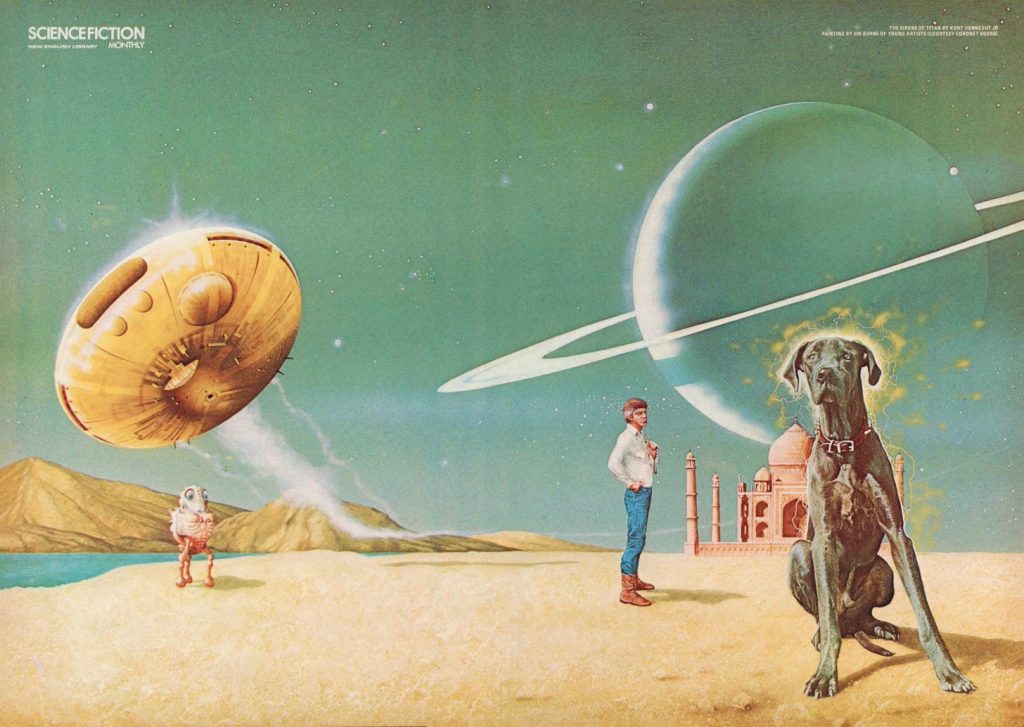
Vonnegut’s most acclaimed novel was Slaughterhouse-Five (1969), now also available as a graphic novel, published in 2020, adapted by Ryan North and Albert Montey.
On first release in 1969, Slaughterhouse-Five was in the New York Times Best Seller List for 16 weeks, peaking at number four. More significantly, while Vonnegut himself introduced the novel, apologetically, calling it a failure, it was hailed as a timely story about the futility of war and cemented the author’s position as a member of the Anti-Vietnam War Counterculture.
The new documentary Kurt Vonnegut: Unstuck in Time, in select UK cinemas now and to be released on Blu-Ray and DVD this month, too, is a welcome riposte to the Fox and friends. However, the film’s director, Robert B Weide, the Emmy award winning director of Curb Your Enthusiasm and of documentaries on WC Fields, Lenny Bruce and Woody Allen, isn’t so in awe of his subject that he doesn’t acknowledge difficult sides to Vonnegut’s character and behaviour.
It is likely that Vonnegut suffered from life-time depression, despite his childhood role as the family clown. His children recall times when he would fly into a rage. At times, living with him must have seemed like walking on eggshells. But there is a sense that Vonnegut’s nephews and children accommodated the sadness that haunted his life.
The film cites a Rolling Stone interview during which Vonnegut announced, “Here’s the news: I am going to sue the Brown & Williamson Tobacco Company, manufacturers of Pall Mall cigarettes, for a billion bucks! Starting when I was only twelve years old, I have never chain-smoked anything but unfiltered Pall Malls. And for many years now, right on the package, Brown & Williamson have promised to kill me. But I am eighty-two. Thanks a lot, you dirty rats…”
Ironically, Vonnegut’s father died of lung cancer, brought on by a life of heavy smoking. He had also patented a self cleaning pipe for smokers. The one visual effect in the documentary foregrounds are animated puffs of smoke arising from Vonnegut jnr’s cigarettes.
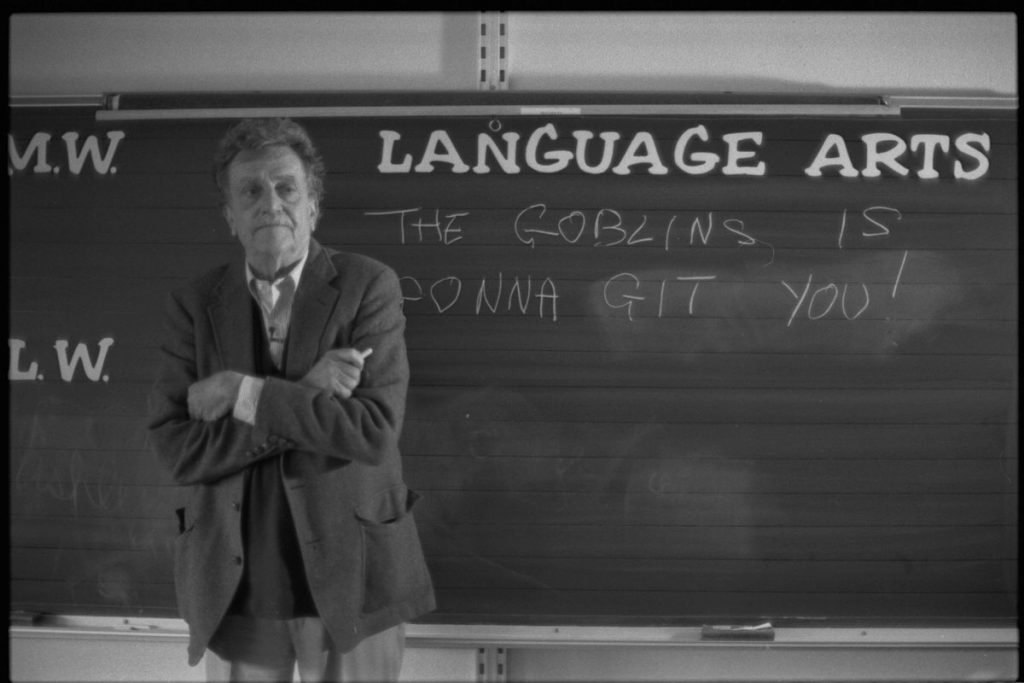
The documentary’s title is intended to evoke the situation of Billy Pilgrim, the focus of Slaughterhouse-Five, who becomes unstuck in time and finds his consciousness slipping between past, present and future. Pilgrim comes to see his life from the perspective of the alien Tralfamadorians for whom a person’s past, present and future are a fait accompli complete. When a human dies, the Tralfamadorians simply note, “So it goes”.
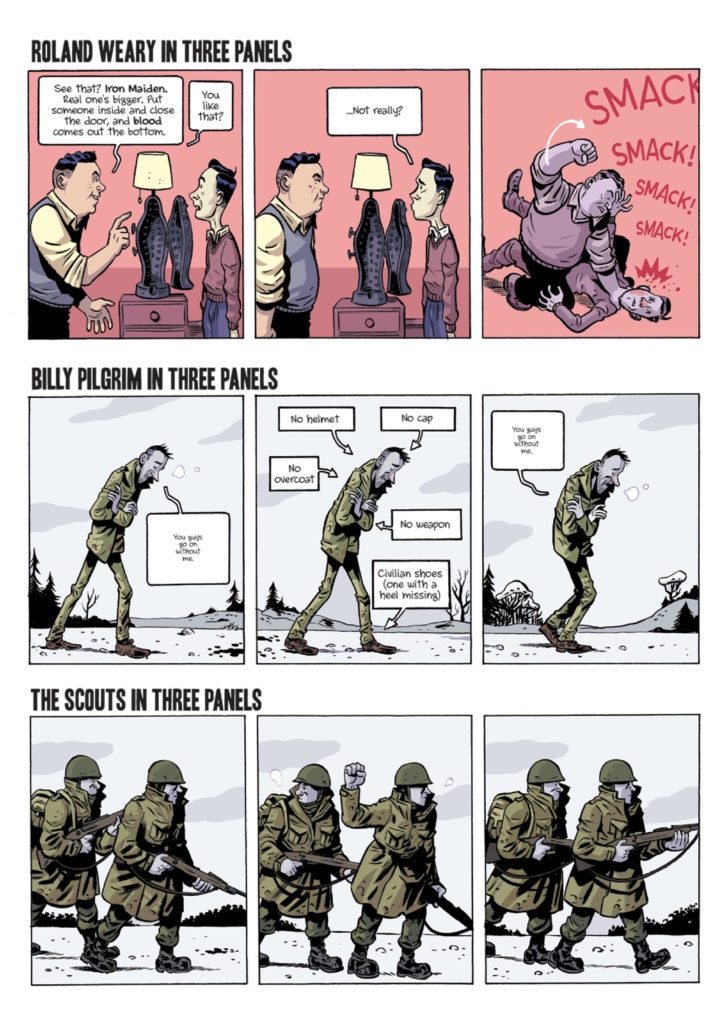
Biographers are in a similar position to the Tralfamadorians. The lives they retell in bio-pics and documentaries are often done deals, except that we expect a more meaningful interpretation of those lives than “so it goes”. Weide has gathered a wealth of material, including interviews with family members, photographic materials,newspaper clippings, and on-the-hoof interviews with Vonnegut himself. But the director’s attempt at a non-linear history could only be partly successful.
Reflecting on the documentary, I was reminded of social historian Carolyn Steedman’s observation that the historian “can move about amid the order of things, present ends before beginnings, write
thematically among the dates. But despite this, it still ends up as a story to do with time and causal connection, because that knowledge of chronology and time, that ‘basic historicity’ is there already, in the head of the reader. I could write it (a life history) backwards indeed, and you would still know that it happened forward”.
Despite its fragmentary nature, Weide’s documentary can be made meaningful along the lines of one of our society’s favourite narrative forms – identified by Vonnegut as “man falls in hole then digs his way out”. Vonnegut falls repeatedly into emotional holes and other kinds created by the natural drama of a life whose circumstances are not of his own making: the decline of the lucrative magazine market for short stories forced him to turn to writing novels, his experiences as a prisoner of war provided the heart of his most famous novel.
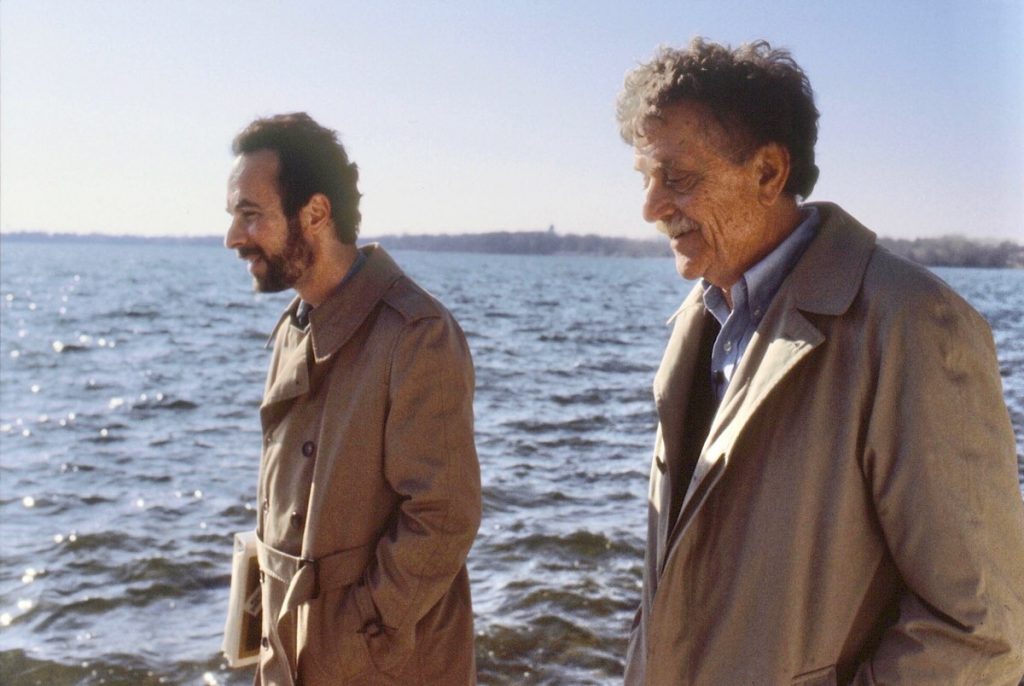
Into the thread of Vonnegut’s life, Weide also weaves in his own, long-standing fascination and friendship with Vonnegut, what appears to be a mutual infatuation, “I love you” Vonnegut mutters to Weide. Sometimes, this juxtaposition of the aged, world-worn Vonnegut with Weide’s fresh-faced, somewhat gauche golly-gee-whizzery is jarring. The shot of Weide rising to receive his Emmy as director of Curb Your Enthusiasm is particularly odd and resonates in ways that have nothing to do with Vonnegut other than to suggest that Weide’s own fame had something to do with the documentary being financed and distributed.
Kurt Vonnegut: Unstuck in Time is not a hagiography. The author was clearly a difficult character, prone to depression and anger. Not everything we laugh at is funny and there are societal emotional norms for when and where it is appropriate to laugh and about what. Vonnegut’s habit of laughing at tragic situations was certainly a challenge to those around him. Added to this, Vonnegut’s mind manufactured juxtapositions between events that other minds would keep separate.
It’s easy to see the dark, even unconscious, playfulness at work in the alternative title of Slaughterhouse-Five, “The Children’s Crusade: A Duty Dance With Death”, from the fact that Vonnegut survived the firebombing of Dresden by being held in a meat locker of a slaughterhouse, to the quirk of spelling that the otherwise disparate words slaughter and laughter are separated by only one letter.
There are a lot of interesting paths not taken by the documentary, and some observations by Weide that are so pedestrian I groaned inwardly – “I couldn’t believe what I was seeing!” He exclaims at entirely normal photographs of Vonnegut playing among his siblings. Weide notes that while making the documentary he himself had turned 60, exclaiming “How (expletive deleted) is that!?”. Erm… not that much. So it goes mate, so it goes.
By the end of the documentary, I felt that I’d got as close to Weide and Vonnegut as I’d really want to get.
Tim Robbins
• Kurt Vonnegut – Unstuck in Time is screening now in selected cinemas across the UK, and is available to watch on demand from Altitude Films here | It will be released in North America on 19th November 2022
• Kurt Vonnegut: Unstuck in Time is also to be released on Blu-Ray and DVD (AmazonUK Affiliate Links)
FURTHER READING / VIEWING
• The Kurt Vonnegut Museum and Library
• Kurt Vonnegut’s humorous take on narrative structure – “Kurt Vonnegut, Shape of Stories” (subtitulos castellano)
• Carolyn Steedman’s writing on time, chronology and history can be found here (PDF)
A freelance journalist and Doctor Who fanzine editor since 1978, Tim Robins has written on comics, films, books and TV programmes for a wide range of publications including Starburst, Interzone, Primetime and TV Guide.
His brief flirtation with comics includes ghost inking a 2000AD strip and co-writing a Doctor Who strip with Mike Collins. Since 1990 he worked at the University of Glamorgan where he was a Senior Lecturer in Cultural and Media Studies and the social sciences. Academically, he has published on the animation industry in Wales and approaches to social memory. He claims to be a card carrying member of the Politically Correct, a secret cadre bent on ruling the entire world and all human thought.
Categories: Books, Digital Media, downthetubes Comics News, downthetubes News, Film, Other Worlds, US Comics
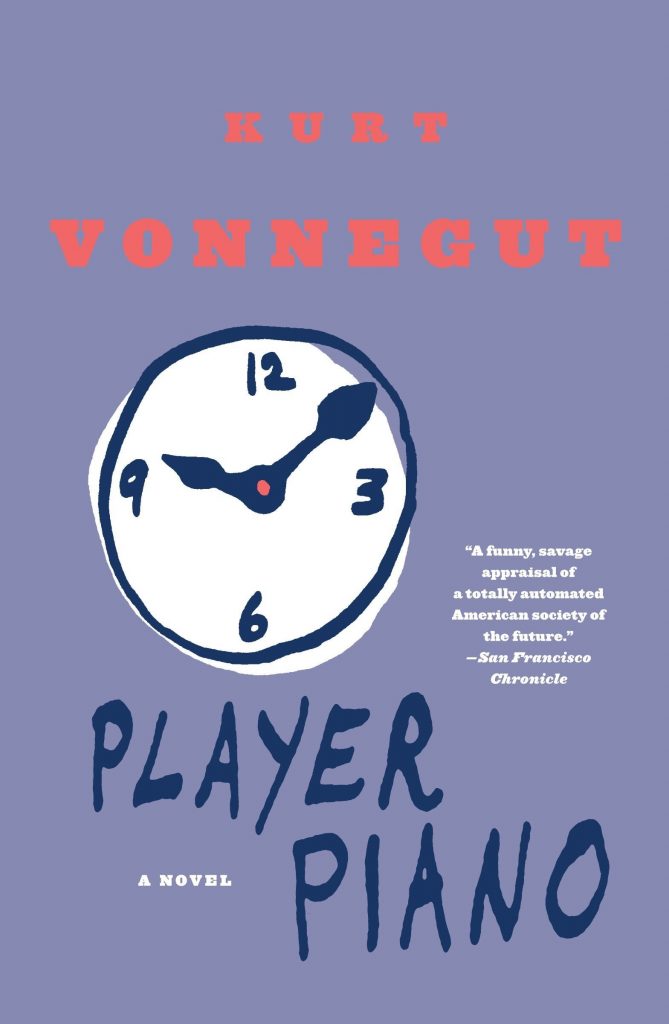

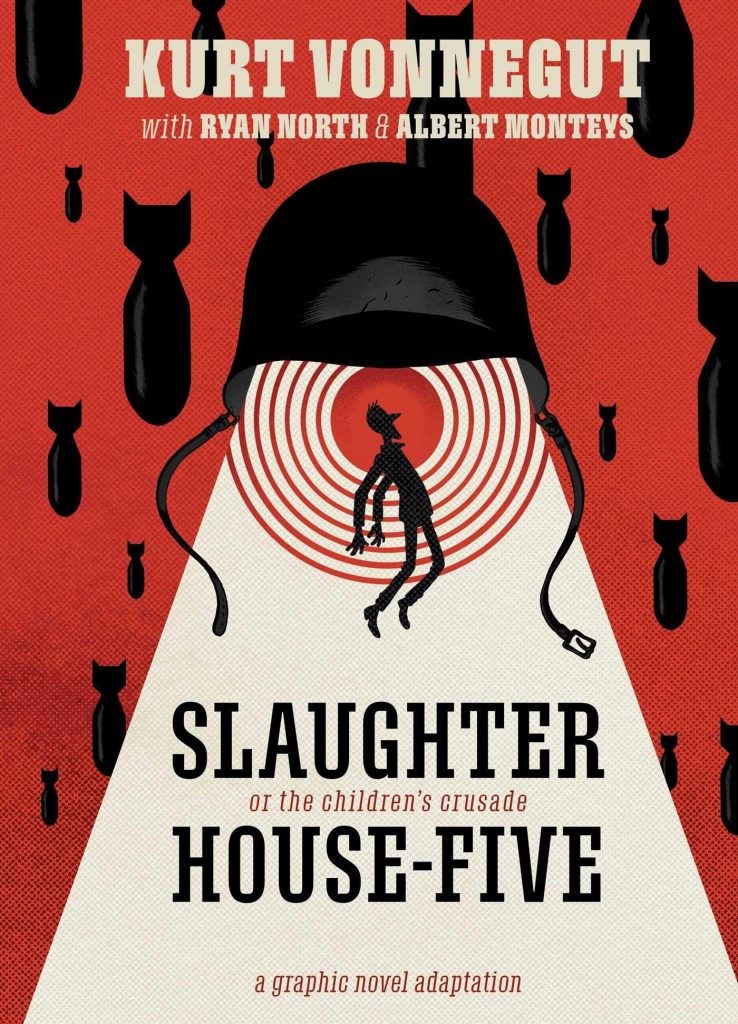

I quite enjoyed the film, but the director definitely made it about himself far too often. I suppose the big trouble with Vonnegut is that he didn’t lead a particularly exciting life outside of writing and speaking engagements once his early, formative wartime experiences were over. He had a few lousy jobs, he had a family, he wrote. That’s it, really. He had a lot of interesting things to say, but he wasn’t larger than life in himself. A biopic of him would be very boring indeed. If you want to experience Vonnegut, read his books.